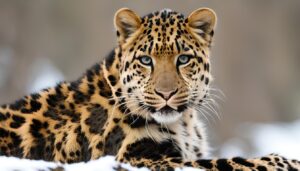Amur leopard endangered species
Amur Leopard: An Endangered Species on the Brink of Extinction
The Amur leopard (Panthera pardus orientalis) is one of the most critically endangered big cats in the world. With its strikingly beautiful coat and elusive nature, the Amur leopard is a symbol of the wild, yet its existence is hanging by a thread. Found primarily in the temperate forests of the Russian Far East, this magnificent creature faces numerous threats that have pushed it to the edge of extinction.

The Magnificent Amur Leopard
The Amur leopard is known for its thick, luxurious coat, which is a pale cream color in winter and more reddish-yellow in summer. Its rosettes and spots are widely spaced, providing excellent camouflage in its forested habitat. Adult males typically weigh between 70-105 pounds, while females are slightly smaller, weighing 55-95 pounds. Their long legs and powerful build enable them to navigate through the deep snow and rugged terrain of their environment with ease.
Habitat and Range
The Amur leopard’s primary habitat is the temperate forests of the Russian Far East, particularly in the Primorye region. Historically, their range extended into China and the Korean Peninsula, but today, they are mostly confined to a small area in Russia. The Land of the Leopard National Park, established in 2012, provides a protected area for these leopards, offering them a sanctuary where they can live and breed.
Why is the Amur Leopard Endangered?
Several factors contribute to the precarious status of the Amur leopard:
- Habitat Loss: Deforestation and human encroachment have significantly reduced the leopard’s habitat. Logging, agricultural expansion, and infrastructure development have fragmented the forests, making it difficult for the leopards to find sufficient prey and mates.
- Poaching: Despite legal protections, poaching remains a significant threat. Amur leopards are hunted for their beautiful pelts and for traditional medicine. The scarcity of prey species, which are also hunted by humans, exacerbates the problem.
- Human-Wildlife Conflict: As human populations grow and expand into leopard territories, conflicts between leopards and humans increase. Leopards may prey on livestock, leading to retaliation from farmers.
- Inbreeding: With a population estimated at fewer than 100 individuals, the genetic diversity of the Amur leopard is extremely low. Inbreeding can lead to health problems and reduced reproductive success, further endangering the species.
Conservation Efforts
Efforts to save the Amur leopard are ongoing and multifaceted. Key initiatives include:
- Protected Areas: The establishment of the Land of the Leopard National Park has been a significant step in providing a safe habitat for the leopards. Strict anti-poaching measures and habitat restoration projects are in place to support the population.
- Anti-Poaching Efforts: Conservation organizations work with local authorities to enforce anti-poaching laws, monitor leopard populations, and educate communities about the importance of protecting these animals.
- Breeding Programs: Captive breeding programs aim to increase the genetic diversity and population size of the Amur leopard. Zoos and wildlife reserves around the world participate in these programs, with some leopards being reintroduced into the wild.
- Community Involvement: Engaging local communities in conservation efforts is crucial. Programs that promote sustainable livelihoods and reduce human-wildlife conflict help create a more harmonious coexistence between humans and leopards.
The Future of the Amur Leopard
The road to recovery for the Amur leopard is long and fraught with challenges, but there is hope. Conservation efforts have shown positive results, with a slight increase in population numbers in recent years. Continued support, both locally and globally, is essential to ensure that future generations can witness the beauty and majesty of the Amur leopard in the wild.
By raising awareness and supporting conservation initiatives, we can help protect the Amur leopard and ensure that this incredible species does not disappear from our planet. Every action, no matter how small, contributes to the survival of these magnificent big cats. Together, we can make a difference and bring the Amur leopard back from the brink of extinction.